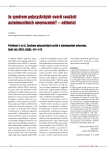Polycystic ovary syndrome and autoimmune diseases
Authors:
J. Petríková; I. Lazúrová
Authors‘ workplace:
I. interná klinika Lekárskej fakulty UPJŠ a FN L. Pasteura Košice, Slovenská republika, prednostka prof. MU Dr. Ivica Lazúrová, CSc.
Published in:
Vnitř Lék 2010; 56(5): 414-417
Category:
Reviews
Overview
Polycystic ovary syndrome (PCOS) is characterized by laboratory or clinical signs of hyperandrogenism with chronic anovulation and is currently one of the most frequent endocrinopaties in women of fertile age. Syndrome is associated with a variety of endocrine and metabolic disturbances and according to results of scientific work could be possibly associated with some autoimmune diseases. It seems that the prevalence of autoimmune tyroiditis is important among these patients. Recent studies reveal higher incidence of organ – non specific autoantibodies, but their clinical significance is unknown to date. Further studies are required to determine the role of organ specific and non‑specific autoantibodies in patients with PCOS. According to determine an etiology of the syndrome one of the possible outcomes could be investigation of anti‑follicular antibody.
Key words:
PCOS – autoimmunity – etiology – autoantibodies
Sources
1. Azziz R, Carmina E, Dewaill D et al. The Androgen Excess and PCOS Society criteria for the polycystic ovary syndrome: the complete task force report. Fertil Steril 2009; 91 : 456 – 488.
2. Rotterdam ESHRE/ ASRM ‑ sponsored PCOS workshop group. Revised 2003 consensus on diagnostic criteria and long‑term health risks related to polycystic ovary syndrome (PCOS). Hum Reprod 2004; 19 : 41 – 47.
3. Asunción M, Calvo RM, San Millán JL et al. A prospective study of the prevalence of the polycystic ovary syndrome in unselected Caucasian women from Spain. J Clin Endocrinol Metab 2000; 85 : 2434 – 2438.
4. Knochenhauer ES, Key TJ, Kahsar ‑ Miller M et al. Prevalence of the polycystic ovary syndrome in unselected black and white women of the southeastern United States: a prospective study. J Clin Endocrinol Metab 1998; 83 : 3078 – 3082.
5. Lazúrová I, Dravecká I. Inzulínová rezistencia a syndróm polycystických ovárií. Via Practica 2005; 5 : 236 – 239.
6. Hardiman P, Pillay OC, Atiomo W. Polycystic ovary syndrome and endometrial carcinoma. Lancet 2003; 361 : 1810 – 1812.
7. Cibula D, Henzl MR, Zivny J et al. Základy gynekologické endokrinologie. Praha: Grada Publishing 2002.
8. Dunaif A. Insulin resistance and the polycystic ovary syndrome: mechanism and implications for pathogenesis. Endocr Rev 1997; 18 : 774 – 800.
9. Franks S. Polycystic ovary syndrome. N Engl J Med 1995; 333 : 853 – 861.
10. Holte J. Disturbances in insulin secretion and sensitivity in women with the polycystic ovary syndrome. Baillieres Clin Endrocrionol Metab 1996; 10 : 221 – 247.
11. Lahita RG. Gender disparity in systemic lupus erythematosus, thoughts after the 8th International Congress on Systemic Lupus Erythematosus, Shanghai, China, 2007. J Clin Rheumatol 2008; 14 : 185 – 187.
12. Li J, Su JM, Zeng XJ. Is primary biliary cirrhosis another example of an immune ‑ mediated complication of Klinefelter syndrome? J Clin Rheumatol 2004; 10 : 286 – 287.
13. Rovenský J, Imrich R, Lazúrová I et al. Rheumatic Diseases and Klinefelter’s Syndrome. Ann N Y Acad Sci 2010; 1193 : 1 – 9.
14. Lonsdale RN, Roberts PF, Trowell JE. Autoimmune oophoritis associated with polycystic ovaries. Histopathology 1991; 19 : 77 – 81.
15. van Gelderen CJ, Gomes dos Santos ML. Polycystic ovarian syndrome. Evidence for an autoimmune mechanism in some cases. J Reprod Med 1993; 38 : 381 – 386.
16. Fénichel P, Gobert B, Carré Y et al. Polycystic ovary syndrome in autoimmune disease. Lancet 1999; 353 : 2210.
17. Palacio JR, Iborra A, Ulcova ‑ Gallova Zet al. The presence of antibodies to oxidative modified proteins in serum from polycystic ovary syndrome patients. Clin Exp Immunol 2006; 144 : 217 – 222.
18. Luborsky J. Ovarian autoimmune disease and ovarian autoantibodies. J Womens Health Gend Based Med 2002; 11 : 585 – 599.
19. Rojansky N, Roll D, Meirow D. Polycystic ovary syndrome. An autoimmune disease? J Reprod Med 1997; 42 : 325 – 328.
20. Gleicher N, El ‑ Roeiy A, Confino E et al. Is endometriosis an autoimmune disease? Obstet Gynecol 1987; 70 : 115 – 122.
21. Janssen OE, Mehlmauer N, Hahn S et al. High prevalence of autoimmune thyroiditis in patients with polycystic ovary syndrome. Eur J Endocrinol 2004; 150 : 363 – 369.
22. Wakim AN, Polizotto SL, Burholt DR. Augmentation by thyroxine of human granulosa cell gonadotrophin‑induced steroidogenesis. Hum Reprod 1995; 10 : 2845 – 2848.
23. Poppe K, Velkeniers B, Glinoer D. Thyroid disease and female reproduction. Clin Endocrinol (Oxf) 2007; 66 : 309 – 321.
24. Paavonen T. Hormonal regulations of immune responses. Ann Med 1994; 26 : 255 – 258.
25. Roussev RG, Kaider BD, Price DE et al. Laboratory evaluation of women experiencing reproductive failure. Am J Reprod Immunol 1996; 35 : 415 – 420.
26. Lahita RG. The role of sex hormones in systemic lupus erythematosus. Curr Opin Rheumatol 1999; 11 : 352 – 356.
27. Lee SH, Kim MR, Kim JH et al. A patient with combined polycystic ovary syndrome and autoimmune polyglandular syndrome type 2. Gynecol Endocrinol 2007; 23 : 252 – 256.
28. Reimand K, Talja I, Metsküla I et al. Autoantibody studies of female patients with reproductive failure. J Reprod Immunol 2001; 51 : 167 – 176.
29. Hefler ‑ Frischmuth K, Walch K, Huebl Wet al. Serologic markers of autoimmunity in women with the polycystic ovary syndrome. Fertil Steril 2009; 92 : 60.
Labels
Diabetology Endocrinology Internal medicineArticle was published in
Internal Medicine

2010 Issue 5
Most read in this issue
- Familial hypercalcemia and hypophosphatemia: importance in differential diagnosis of disorders in calcium‑ phosphate metabolism
- A review of the effects of prolactin hormone and cytokine on the development and pathogenesis of autoimmune diseases
- Polycystic ovary syndrome and autoimmune diseases
- ILCOR recommendation on signing of automated external defibrillators (AEDs)
